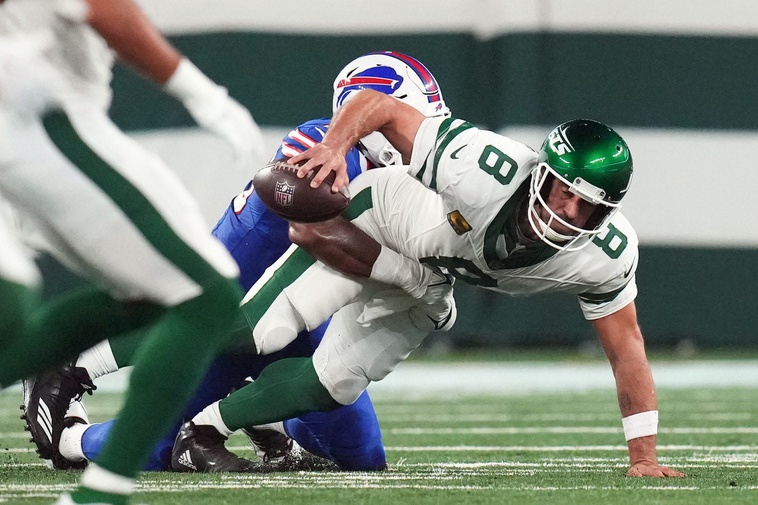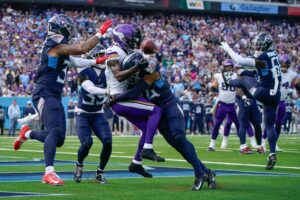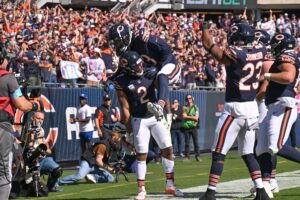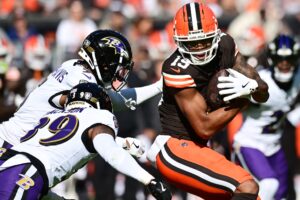On a clear day in 1993 at the Vet in Philadelphia, wide receiver Wendell Davis looked over his shoulder to catch a long, underthrown pass from Chicago Bears quarterback Jim Harbaugh. Davis would stop in full sprint. As he planted to jump for the catch, his cleats would get stuck in the astroturf at Veterans Stadium. As if glued to the carpet, Davis felt something snap in both knees.
When team doctors rushed to his side, they immediately straightened both of his legs. As they began to determine what exactly had happened, Davis looked down to see for himself. He saw Chicago personnel trying to locate his kneecaps, which they would find “up in his thighs”. On that same day in Indianapolis, Steve Emtman violently tore his anterior cruciate ligament, medial collateral ligament, and patellar tendon, all while in pursuit of Emmett Smith on the turf inside of the Hoosier Dome.
A History of The NFL And the Turf Argument
The advent of AstroTurf can be traced to the 1950s to battle growing urban sprawl and less grassy playgrounds for children. The Ford Foundation financed the research for a turf-like substance to mimic grass playing surfaces. Eventually, the green turf found its way into the Astrodome and ushered in the first grassless game between the Houston Astros and the Los Angeles Dodgers. Within five years, more than 12 stadiums were using AstroTurf.
From Foxboro Stadium in New England to Candlestick Park in San Francisco, AstroTurf was the way to go for NFL teams. It was also all the rage of the cookie-cutter multi-purpose facilities in cities like Cincinnati, Pittsburgh, Philadelphia, Chicago, Candlesticks Park and the Meadowlands used the carpet as well.
Scorching hot temperatures when it’s hot and icy slick conditions in colder months, AstroTurf was an era players loved to see go away. But the end of one artificial surface only led to an explosion of other types of synthetics. The chorus of players who preferred grass grew louder, especially when the turf’s latest victim is a superstar in New York.
Down Goes Rodgers
Four plays into their home opener against the Buffalo Bills, New York Jets quarterback Aaron Rodgers would suffer a complete tear to his Achilles tendon just four plays into his debut in Gotham.
MetLife Stadium, which is the home of the Jets, uses what is called a multilayer dual-polymer monofilament fiber called FieldTurf Core. Players have noted the “grabby” effect of the “harder and faster” surface designed to release the cleats a player wears. But is the turf at MetLife what ended Rodgers’ season before it even started? Could this high-profile injury be the Clarion Call for the NFL to finally have every stadium use grass instead of the synthetic fields hailed as a breakthrough nearly 70 years ago?
As with all things that have a price tag, it boils down to the dollars and cents of the investment. However, with those “dollars and cents” spent on players, are owners also willing to invest in their team as they do in their palatial amenities to be a crown jewel in the league’s roster of stadiums?
An Inconvenient Truth: Turf vs. Grass
Grass is a complicated subject on a football field and does not seem like a difficult fix. The fact is, for every argument an injury caused on turf generates, an injury on grass seems to even out the discussion. This past Sunday, Baltimore Ravens running back J.K. Dobbins tore his Achilles at M&T Bank Stadium – a stadium that has natural grass as its playing surface.
On Wednesday, September 13, the NFLPA released a statement saying all NFL fields should move to a natural grass surface. Commissioner Roger Goodell countered by saying, “What we want to go by is the science, we want to go on what’s the best from an injury standpoint”.
The injury to Rodgers aside, the NFL has been willing to use science as their baseline for such dramatic and evolutionary changes when it comes to playing surfaces. The league is correct to note that injuries happen on grass as well as on field turf, leaving one to wonder if there truly is an answer.
That answer may require us to look back before looking forward. Players like Johnny Unitas, Joe Namath, Gayle Sayers, Troy Aikman, and Joe Theisman are but a few names who live a life in pain. The game in those years is not so unlike the game today. Pain then, as pain is now for players, a constant companion for a brief life in the arena of cheers on a Sunday afternoon.
As for the latest to break down on NFL turf, Aaron Rodgers begins the long road back. When he returns to MetLife, the odds are high that he will also return to the same surface that may or may not be the reason for his injury.
The NFL Turf Argument Rolls On
What began in March 1966 in the Astrodome has seen both an explosion of controversy and innovation. The game once played on grass is now played mostly on synthetics. While some may profess to like its speed, the cost for that speed can be high. As for the savings on maintenance, do the math for watering a football field. The arguments for both sides are many and varied.
All that said, for the injuries and lifetime of chronic pain many players will wince. Some will shake their head and some, albeit a few, will harbor regrets. But the overwhelming number of current and former NFL players wouldn’t trade a moment of a Sunday afternoon in the arena, for the roar of the fans and fleeting greatness remains the NFL’s greatest aphrodisiac, even on turf.
“In five to 10 years any problems about playing championship games in cold-weather towns will be resolved. We’ll have artificial turf on all of our fields by then.” NFL commissioner Pete Rozelle, Sports Illustrated – January 27, 1969.
Main Photo: Danielle Parhizkaran – USA Today Sports






